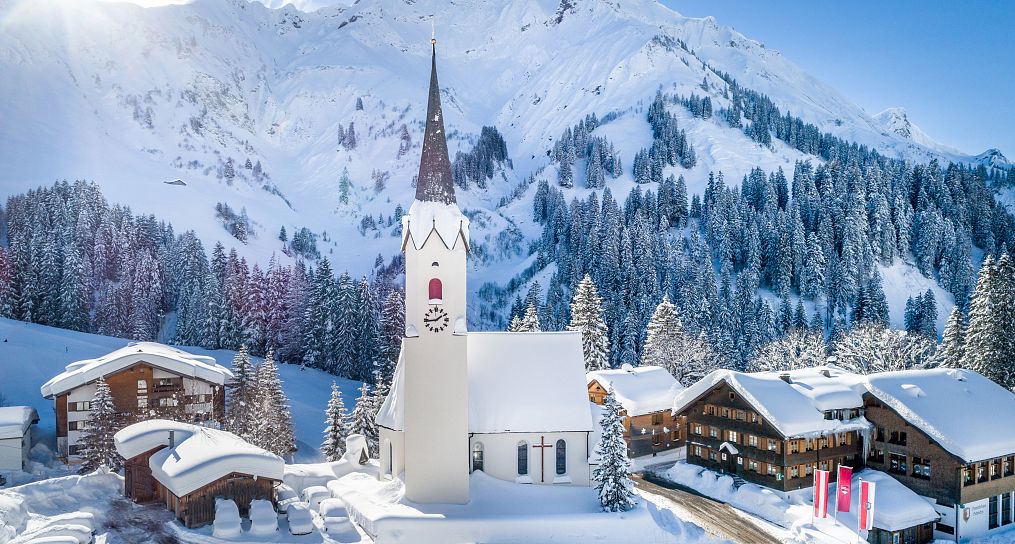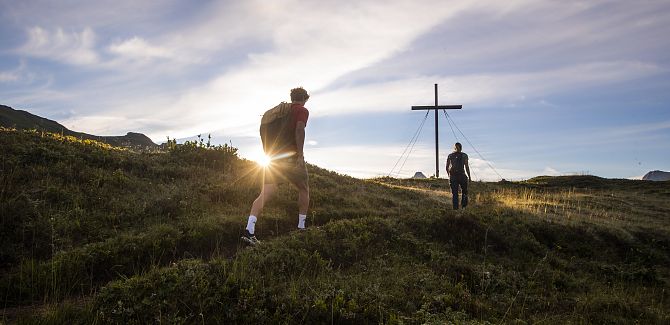Churches and chapels in Warth-Schröcken.
A place of reflection and peace.
The charming churches in Warth and Schröcken are not only architectural highlights but also spiritual retreats that are worth a visit. Step inside to admire the impressive altars, vibrant stained glass windows, and sacred figures. These places invite not only the appreciation of art but also provide a space to enjoy peace and quiet, allowing for reflection.
In addition, you will find a variety of idyllic chapels in and around Warth-Schröcken, each with its own unique history and significance. These small, tranquil locations are often easily accessible via short and gentle hikes, making them perfect destinations for a relaxing outing in nature.
Allow yourself to be enchanted by the peaceful atmosphere of these churches and chapels as you experience the spiritual power of the area. Enjoy the harmonious blend of culture, history, and nature, and gather unforgettable impressions in the picturesque surroundings of Warth-Schröcken.

Parish church of Warth – catholic parish church of St. Sebastian.
The Roman Catholic Parish Church of St. Sebastian in Warth am Arlberg is a significant religious and cultural landmark of the community of Warth in the Bregenz district of Vorarlberg. The church belongs to the Hinterwald deanery in the Diocese of Feldkirch and is a protected monument, underscoring its historical and architectural importance.
History.
The history of the parish church is closely linked to the development of the region. Originally established as a branch of Lech, the church was built between 1590 and 1592 and was consecrated in 1602 to Saints Anne and Sebastian. By 1602/1603, it had received the status of a chapel and was elevated to parish church status in 1625. From 1749 to 1752, the church underwent significant expansion and refurbishment. A comprehensive renovation took place in 1791, during which stucco work by Johann Jakob Rief was added. Between 1893 and 1895, the parish church was rebuilt under the guidance of master builder Fidel Körner. On September 1, 2012, the church finally transitioned from the Bludenz-Sonnenberg deanery to the Hinterwald deanery.
Architecture.
Architecturally, the parish church impresses with its neo-Romanesque style. It is surrounded to the east by a walled cemetery, which adds a unique atmosphere to the church. The nave and the chancel, which feature a harmonious three-quarter closure, are unified under a common gabled roof. Notably, the north tower at the chancel is topped with an elegant spire. The church's entrance is adorned with a stylishly integrated shed roof.
A visit to the Parish Church of St. Sebastian in Warth offers not only the opportunity to admire its impressive architecture but also to experience the spiritual atmosphere that envelops this historical site.

Parish church of Schröcken – catholic parish church of the assumption of Mary.
The Roman Catholic Parish Church of the Assumption of Mary in Schröcken is a significant structure within the Bregenzerwald municipality of Schröcken, located in the Bregenz district of Vorarlberg. Dedicated to the feast of the Assumption of Mary, it belongs to the Hinterwald deanery in the Diocese of Feldkirch. The building is a protected monument, reflecting the rich history and cultural significance of the region.
History.
The history of the parish church begins as a subsidiary church of the parish of Lech. The first consecration took place in 1639, and by 1640, the church was elevated to chapel status, ultimately becoming a parish church in 1661. From 1726 to 1732, the original church underwent expansion, followed by a restoration in 1773. The church tower, a prominent feature of the building, dates back to 1785, with the spire added in 1786. Following a devastating fire in 1863, the church was rebuilt between 1864 and 1867 and was reconsecrated at the end of these works in 1867.
Architecture.
Exterior
The parish church features a neo-Romanesque nave and a slightly recessed chancel, both of which are topped by a harmonious gabled roof. The entrance is adorned with a prominent triangular pediment. On the north side, the tower rises with an elegant spire. Both the nave and the chancel are designed simply, lacking decorative elements. The tower boasts an octagonal upper level with round-arched sound openings, and between this level and the spire, there is a stylish pediment.
Interior
Inside the church, visitors are greeted by a flat-ceilinged vestibule leading to a staircase that ascends to the gallery. The walls of the nave are pierced on both sides by three round-arched windows, creating a pleasant light atmosphere. Above the nave, a barrel vault with short transverse arches stretches, accompanied by a heavy cornice running around the perimeter. The tall triumphal arch is recessed, and the chancel terminates in a 3/8 form, also featuring a barrel vault that continues the connection to the nave.
In the west of the nave, there is a straight double gallery supported by two curved columns. The intricate stained glass windows come from the Schnitzler stained glass workshop in Dornbirn. In the chancel, St. Agnes is depicted on the left side and St. Aloysius on the right side, underscoring the spiritual significance of the church.
A visit to the Parish Church of the Assumption of Mary in Schröcken offers not only the opportunity to admire the impressive architecture and artworks but also to experience a place of peace and reflection.



